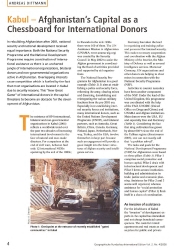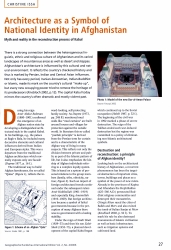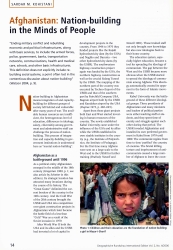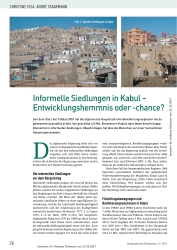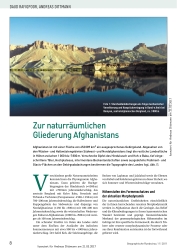By Andreas Dittmann - In rebuilding Afghanistan after 2001, national security and national development received equal importance. Both the National Security Programme and the National Development Programme require coordination of international assistance as there is an uncharted jungle of international organizations, bilateral donors and non-governmental organizations active in Afghanistan. Overlapping interests cause competition which is fuelled by the fact that most organisations are located in Kabul due to security reasons. This "New Great Game" of international donors in the capital threatens to become an obstacle for the development of Afghanistan.
|
Title |
Kabul - Afghanistan's Capital as a Chessboard for International Donors |
|
|
Author |
Andreas Dittmann |
|
|
Language |
English |
|
|
Year |
2006 |
|
|
Geographische Rundschau International Ed. |
DITTMANN, A. (2006): Kabul - Afghanistan's Capital as a Chessboard for International Donors. In: Geographische Rundschau International
By Christine Issa - There is a strong connection between the heterogeneous linguistic, ethnic and religious culture of Afghanistan and its varied landscapes of mountainous areas as well as desert and steppes. Afghanistan's architecture is influenced by this cultural and natural environment. It reflects the country's checkered history and thus is marked by Persian, Indian and Central Asian influences. Not only has every period, Iranian-Zoroastrian, Indian-Buddhist or Islamic, made its mark on the country's cultural "make-up", but every new occupying power tried to remove the heritage of its predecessors. The capital Kabul today mirrors the country's often dramatic and mostly violent past.
|
Title |
Architecture as a Symbol of National Identity in Afghanistan |
|
| Myth and reality in the reconstruction process of Kabul | ||
|
Author |
Christine Issa |
|
|
Language |
English |
|
|
Year |
2006 |
|
|
Geographische Rundschau International Ed. |
ISSA, C. (2006): Architecture as a Symbol of National Identity in Afghanistan. Myth and reality in the reconstruction process of Kabul. In: Geographische Rundschau International Edition Jg. 2, H. 4, S. 27-32.
By Sardar Mohammad Kohistani - Nation-building in Afghanistan means integration of and capacitybuilding for different groups of society left behind and vulnerable after many years of war. The available human resources are insufficient, the heterogeneous level of education, differences in ideology, salary, citizenship among government and administrative staff can challenge the process of nationbuilding. This process of integration and capacity-building in government institutions is understood here as "mental nation-building".
|
Title |
Afghanistan: Nation-building in the Minds of People |
|
|
Author |
Sardar Mohammad Kohistani |
|
|
Language |
English |
|
|
Year |
2006 |
|
|
|
Geographische Rundschau International Ed. |
KOHISTANI, S. M. (2006): Afghanistan: Nation-building in the Minds of People. In: Geographische Rundschau International Edition Jg.2, H. 4,S. 14-18.
Von Christine Issa & André Staarmann - Seit dem Sturz der Taliban 2001 hat die afghanische Hauptstadt eine Bevölkerungsexplosion nie da gewesenen Ausmaßes erlebt. Von geschätzt 4,5 Mio. Einwohnern Kabuls aber leben derzeit knapp Dreiviertel in informellen Siedlungen. Obwohl illegal, hat dies die Menschen vor einer humanitären Katastrophe bewahrt.
|
Titel |
Informelle Siedlungen in Kabul |
|
| Entwicklungshemmnis oder -chance? | ||
|
Autoren |
Christine Issa, André Staarmann |
|
|
Sprache |
Deutsch |
|
|
Jahr |
2011 |
|
|
In |
Geographische Rundschau |
ISSA, C. u. A. STARMANN (2011): Informelle Siedlungen in Kabul - Entwicklungshemmnis oder -chance? In: Geographische Rundschau Jg. 63, H. 11, S. 26-31.
Von Daud Rafiqpoor & Andreas Dittmann - Afghanistan ist mit einer Fläche von 652 089 km2 ein ausgesprochenes Gebirgsland. Abgesehen von den Wüsten- und Halbwüstengebieten Südwest- und Nordafghanistans liegt die restliche Landesfläche in Höhen zwischen 1 000 bis–7 800 m. Verschneite Gipfel des Hindukusch und Koh-e Baba, tief eingeschnittene Täler, Hochplateaus, intermontane Beckenlandschaften sowie ausgedehnte Pediment- und Glacis-Flächen an den Gebirgsabdachungen bestimmen die Topographie des Landes.
|
Titel |
Zur naturräumlichen Gliederung Afghanistans |
|
|
Autoren |
Andreas Dittmann, Daud Rafiqpoor |
|
|
Sprache |
Deutsch |
|
|
Jahr |
2011 |
|
|
In |
Geographische Rundschau |
DITTMANN, A. u. D. RAFIQPOOR (2011): Zur naturräumlichen Gliederung Afghanistans. In: Geographische Rundschau Jg. 63, H. 11, S. 8-16.



